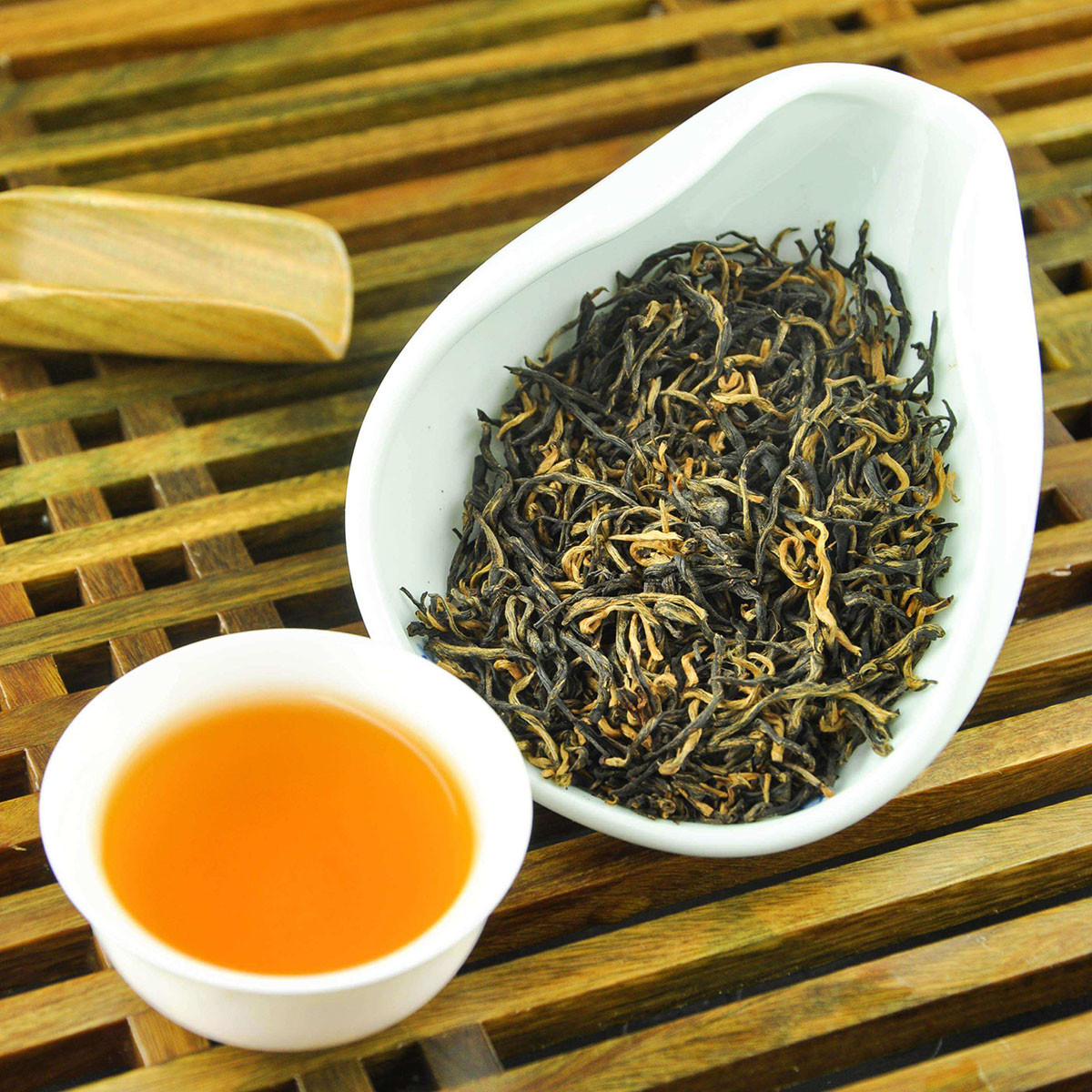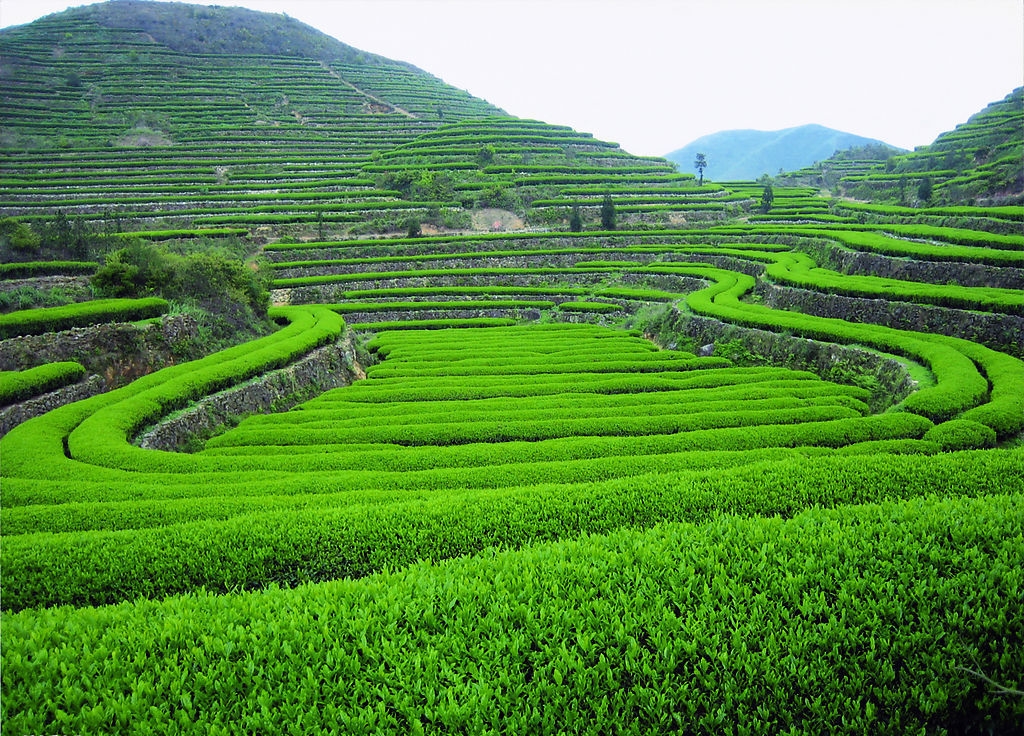
Deutsch-Chinesische Enzyklopädie, 德汉百科
 Hubei Sheng-HB
Hubei Sheng-HB

 Anhui Sheng-AH
Anhui Sheng-AH
 Gansu Sheng-GS
Gansu Sheng-GS
 Guangdong Sheng-GD
Guangdong Sheng-GD
 Guangxi Zhuangzu Zizhiqu-GX
Guangxi Zhuangzu Zizhiqu-GX
 Henan Sheng-HA
Henan Sheng-HA
 Hubei Sheng-HB
Hubei Sheng-HB
 Hunan Sheng-HN
Hunan Sheng-HN
 Jiangxi Sheng-JX
Jiangxi Sheng-JX
 Liaoning Sheng-LN
Liaoning Sheng-LN
 Shandong Sheng-SD
Shandong Sheng-SD
 Shanxi Sheng-SX
Shanxi Sheng-SX
 Sichuan Sheng-SC
Sichuan Sheng-SC
 Tianjin Shi-TJ
Tianjin Shi-TJ

 Anhui Sheng-AH
Anhui Sheng-AH
 Fermentierter Tee
Fermentierter Tee
 Guangxi Zhuangzu Zizhiqu-GX
Guangxi Zhuangzu Zizhiqu-GX
 Hubei Sheng-HB
Hubei Sheng-HB
 Hunan Sheng-HN
Hunan Sheng-HN
 Shaanxi Sheng-SN
Shaanxi Sheng-SN
 Sichuan Sheng-SC
Sichuan Sheng-SC
 Yunnan Sheng-YN
Yunnan Sheng-YN

黒茶の茶葉色は褐色から黒色で、水色は紅茶や烏龍茶に似た濃いオレンジや濃い赤色が多い[1]。中には緑茶に近い水色の方包茶や、抽出するとコロナ状のリングが現れる花巻茶などもある。黒茶の香りは「陳香(ツンシャン)」(熟成した香り)と呼ばれ、その独特な香気は堆積工程で作り出される[1]。茯磚茶の製造には圧製後に「菌花香」と呼ばれる香気を発するカビを加える「発花」と呼ばれる工程がある。
黒茶の味の特徴として、発酵の過程で生じる微生物の代謝によって苦味成分のポリフェノール、旨味成分のアミノ酸が減少し、可溶性糖類が増加することから、他の茶に比べて渋みの少ないまろやかな味となっている[1]。
一般に茶は、若芽が多く新鮮なほど評価が高く、時間の経過とともにその価値が落ちると考えられるが、発酵茶である黒茶は他の茶と異なり成熟したチャノキの葉を使い、枝ごと切り取って製造するものもある[1]。また、熟成が進むとともに苦味や渋味が消え風味が豊かになることから、製造から時間が経ったものほど価値が高い[2]。
Fermented tea (also known as post-fermented tea or dark tea) is a class of tea that has undergone microbial fermentation, from several months to many years. The exposure of the tea leaves to humidity and oxygen during the process also causes endo-oxidation (derived from the tea-leaf enzymes themselves) and exo-oxidation (which is microbially catalysed). The tea leaves and the liquor made from them become darker with oxidation. Thus, the various kinds of fermented teas produced across China are also referred to as dark tea, not be confused with black tea. The most famous fermented tea is kombucha which is often homebrewed, pu-erh, produced in Yunnan Province,[1][2] and the Anhua dark tea produced in Anhua County of Hunan Province.
The fermentation of tea leaves alters their chemistry, affecting the organoleptic qualities of the tea made from them. Fermentation affects the smell of the tea and typically mellows its taste, reducing astringency and bitterness while improving mouthfeel and aftertaste. The microbes may also produce metabolites with health benefits.[1][3]
The fermentation is carried out primarily by molds. Aspergillus niger was implicated as the main microbial organism in the Pu-erh process,[1][4][5] but that species identification has been challenged by comprehensive PCR-DGGE analysis, which points to Aspergillus luchuensis as the primary agent of fermentation.[6][7][8][9]
Most fermented teas are made in China, but several varieties are produced in Japan.[10] In Shan State, Myanmar, lahpet is a form of fermented tea that is eaten as a vegetable, and similar pickled teas are also eaten in northern Thailand and southern Yunnan.[11]
Un thé post-fermenté, parfois dit thé sombre ou thé noir-noir, a subi une période de vieillissement à l'air libre allant de quelques mois à plusieurs années.
Le thé a généralement subi une première oxydation comme le thé noir ou l'Oolong. Puis sous l'influence de moisissures, de levures et de bactéries, il subit une fermentation, en milieu chaud et humide. Il peut alors être vieilli plusieurs années, ce qui changera radicalement son goût, passant de l'astringence et de l'amertume à des saveurs plus onctueuses et terreuses.
Les Chinois appellent littéralement « thé noir » un thé post-fermenté, tandis qu'ils dénomment « thé rouge » ce qu'un Occidental appelle thé noir1,2,3.
Il tè postfermentato è un tipo di tè prodotto con le foglie di Camellia sinensis stabilizzate tramite torrefazione ed eventualmente essiccate, successivamente sottoposte a un processo di fermentazione-ossidazione tramite stagionatura naturale o in particolari condizioni di temperatura e umidità.[1]
Il processo di postfermentazione (in cinese 后发酵 hòu fājiào) si differenzia da quello di ossidazione enzimatica (impropriamente chiamata "fermentazione", in cinese 发酵 fājiào) cui si sottopongono le foglie di tè appena raccolte per la produzione del tè nero e che, nel caso del tè oolong, precede la fase di torrefazione.
In Cina e nei paesi dell'Asia Orientale i tè postfermentati vengono chiamati "tè neri", (cinese 黑茶 hēichá) per il colore delle foglie e dell'infuso. Non si devono confondere con la tipologia dei tè neri conosciuti in Occidente, a loro volta chiamati "tè rossi" in Cina e in Asia Orientale.
Il tè sottoposto a questo processo di lavorazione tipicamente presenta un infuso di colore rosso-marrone scuro, di sapore morbido, con note balsamiche e sentori di legno e terra bagnata.
Постферментированный чай — чай, который прошёл процесс микробной ферментации от нескольких месяцев до многих лет, обычно во влажной среде и при доступе кислорода. Самый известный постферментированный чай пуэр производится в провинции Юньнань, лучшие сорта его — в селении Булан Шань уезда Минхай.
Ферментация влияет на органолептические свойства чая, она меняет запах, как правило, смягчает вкус, уменьшая терпкость и горечь. Микроорганизмы могут также производить метаболиты, полезные для здоровья.
 Beijing Shi-BJ
Beijing Shi-BJ
 China
China
 FIBA Basketball-Weltmeisterschaft
FIBA Basketball-Weltmeisterschaft
 Guangdong Sheng-GD
Guangdong Sheng-GD
 Hubei Sheng-HB
Hubei Sheng-HB
 Jiangsu Sheng-JS
Jiangsu Sheng-JS
 Shanghai Shi-SH
Shanghai Shi-SH

 China
China
 Fußball-Weltmeisterschaft der Frauen 2007
Fußball-Weltmeisterschaft der Frauen 2007
 Hubei Sheng-HB
Hubei Sheng-HB
 Shanghai Shi-SH
Shanghai Shi-SH
 Sichuan Sheng-SC
Sichuan Sheng-SC

 Sport
Sport
 (F)Fußball-Weltmeisterschaft der Frauen
(F)Fußball-Weltmeisterschaft der Frauen
 Tianjin Shi-TJ
Tianjin Shi-TJ
 Zhejiang Sheng-ZJ
Zhejiang Sheng-ZJ

 Anhui Sheng-AH
Anhui Sheng-AH
 Gelber Tee
Gelber Tee
 Guangdong Sheng-GD
Guangdong Sheng-GD
 Hubei Sheng-HB
Hubei Sheng-HB
 Hunan Sheng-HN
Hunan Sheng-HN
 Sichuan Sheng-SC
Sichuan Sheng-SC
 Zhejiang Sheng-ZJ
Zhejiang Sheng-ZJ

Gelber Tee (Gelbtee) ist eine Teesorte, die von ihrem Fermentationsgrad (max. 20 %) zwischen weißem Tee und Oolongtee einzuordnen ist. Seine Sortenvielfalt ist sehr begrenzt, die verfügbaren Mengen gering. Der Tee ist reich an Vitaminen, Antioxidantien und Koffein. Wie auch andere schwach fermentierte Tees fördert er die Magensaftproduktion und wirkt deshalb verdauungsfördernd.[1]
黄茶(きちゃ、ホァンチャ/ファンチャ)は中国茶の一種。
通常の中国緑茶とは異なる加熱処理を行うことと、その後牛皮紙に包み悶黄と呼ばれる熟成工程を経て作られることが製造工程における特徴である。黄茶の加熱処理は低い温度から始まり、徐々に温度を上げ、その後徐々に温度を下げる。この処理法によって、茶葉の持つ酵素による酸化発酵が起こる。中国緑茶の場合、最初から高温に熱した釜に茶葉を投入するため、上記の酸化発酵は(一部、萎凋を施す緑茶はあるが[1])基本的には起こらない。黒茶以外で発酵と呼ばれる青茶は、施される工程と発酵の度合いこそ違えど、酵素による酸化発による酵茶であることは共通している。また、黒茶以外で論ずると、一部の緑茶で萎凋を施すことを勘定[1]すれば、この黄茶とは発酵茶の中では唯一萎凋を施さない種類といえる。
工程で中途半端に酸化発酵した茶葉は、次に悶黄と呼ばれる黄茶独特の熟成工程を経る。この悶黄と呼ばれる工程、微生物による発酵という俗説があるが、これは間違いである。悶黄には微生物は一切関与しない。高湿度高温の環境下茶葉内のポリフェノールを中心とする成分が非酵素的に酸化される[2]工程である。ポリフェノールおよび葉緑素(クロロフィル)は酸化されることで、緑から透明及び黄色へと変色する。これにより茶葉と水色がうっすらとした黄色になるため黄茶と呼ばれる。
代表的な黄茶として君山銀針、霍山黄芽、蒙頂黄芽などが挙げられる。黄茶は清朝皇帝も愛飲したといわれ、中国茶の中でももっとも希少価値が高い。100グラム1万円を超えるものも決して珍しくはない。
Yellow tea can refer to Chinese huángchá (黄茶; 黃茶) and Korean hwangcha (황차; 黃茶).It is an increasingly rare and expensive variety of tea.[3]:58 The process for making yellow tea is similar to that of green but with an added step of encasing and steaming the tea. This allows the tea to oxidize at a slower rate, producing a far more mellow taste than is found in most green teas [4]; this also gives the leaves a slightly yellow colouring during the drying process.[3]:32[4] Yellow tea is often placed in the same category with green tea due to its light oxidation. One of the primary aims of making yellow tea is to remove the characteristic grassy smell of green tea while preserving the associated health qualities of green tea. Some have even speculated that yellow tea may be healthier because it is easier on the stomach than green tea.[5]
Un thé jaune (en Chinois: 黃茶; pinyin: huángchá) est un thé vert chinois qui a subi une phase de fermentation post-enzymatique. Les thés verts de grande qualité sont parfois aussi appelés thé jaune. A la suite de la cueillette, les feuilles de thé sont fermentées à l'étouffée (environ 50°C) avant d'être flétries et torréfiées. Après cette torréfaction et un roulage, les feuilles couvertes d'un tissu humide sont entassées en petits tas, pendant plus de vingt heures, à un degré d'humidité situé entre 80 et 90 %. Elles demeurent ainsi jusqu'à ce qu'elles s'oxydent. Elles subissent ensuite une brève dessiccation.
Il tè giallo (in cinese 黃茶T, 黄茶S, huángcháP; in coreano 황차?, hwangchaLR) è una pregiata variante del tè ottenuta con una parziale ossidazione enzimatica delle foglie della Camellia sinensis.
Dopo la torrefazione e una lieve pressatura, le foglie vengono raccolte in cumuli di piccole dimensioni e coperte con un panno umido, poi sono lasciate per venti ore a un tasso di umidità compreso tra 80 e 90%. Esse rimangono così fino a quando si ossidano, quindi vengono sottoposte ad una breve asciugatura.
La preparazione della bevanda si effettua per infusione, con le stesse modalità del tè verde.
Un altro uso dell'espressione "tè giallo" è per indicare i tè verdi più pregiati.
El té amarillo (en chino: 黃茶, pinyin: huángchá) suele ser un té especial procesado de forma parecida al té verde, pero con una fase de secado más corta, en la que las hojas húmedas se dejan reposar y amarillean. Este té tiene por lo general una apariencia y olor diferentes a los del té blanco o verde. El aroma se confunde a veces con el del té negro si se cura con otras hierbas, pero su sabor sigue siendo similar al del té blanco y el verde.
El término, sin embargo, también alude a los tés de alta calidad servidos en la Corte Imperial, aunque en realidad puede aplicarse a cualquier té servido en ella.
Жёлтый чай — вид чая, подвергшийся слабой ферментации (окислению). Жёлтый чай по классификации по степени ферментации стоит на третьем месте после зелёного, примерно 7—10 % ферментации.
Жёлтый чай изготавливается из сырья высокого качества, исключительно в Китае, в провинциях Сычуань, Хунань, Чжецзян, Фуцзянь. Считается императорским чаем, очень долгое время жёлтый чай тщательно оберегался от иностранцев, за разглашение его тайн строго карали. Известен с эпохи Тан (VIII век н. э.). Долгое время был привилегией только императора и высшей знати. *Changjiang|Yangtze Fluß
*Changjiang|Yangtze Fluß

 Energieressource
Energieressource

 Energieressource
Energieressource
 *Elektrische Energie
*Elektrische Energie

 Energieressource
Energieressource
 Wasserkraftwerke
Wasserkraftwerke
 Erneuerbare Energie
Erneuerbare Energie
 Wasserkraft
Wasserkraft
 Hubei Sheng-HB
Hubei Sheng-HB

Die Gezhouba-Talsperre (chinesisch 长江葛洲坝水利枢纽工程, englisch Gezhouba Dam bzw. Gezhouba Water Control Project) ist eine Talsperre am Jangtsekiang mit einem Wasserkraftwerk und drei Schleusen. Sie wurde bei Yichang in der Provinz Hubei in Zentralchina erbaut und liegt 38 km unterhalb der Drei-Schluchten-Talsperre.
Die Gezhouba-Talsperre ist das erste Wasserkraftwerk, welches am Jangtsekiang erbaut wurde.[1] Nach der Inbetriebnahme 1988 war es auch das leistungsstärkste in China.
Gezhouba gehört zu den 100 größten Wasserkraftwerken der Erde. Es hat eine Gesamtleistung von 2.715 Megawatt und eine Jahresstromproduktion von 14.100 GWh. Die Anlage wird von der China Three Gorges Corporation (CTG) betrieben.
葛洲坝水利枢纽,被誉为“万里长江第一坝”,是长江干流上第一座大型水利枢纽,位于中国湖北省宜昌市境内的长江三峡末端河段上,距上游的三峡水电站38公里,距下游宜昌市主城区约6公里。因坝址所在江面原有一名为葛洲的沙洲而得名。
葛洲ダム(ガージョウ・ダム、中国語: 葛洲坝、英語: Gezhou Dam))は葛洲ダム水利センター(中国語: 葛洲坝水利枢纽、英語: Gezhou Dam Water Control Center)とも呼ばれ、中国湖北省宜昌市にあるダムである。
長江に黄柏河が流れ込むところにあり、ここは三峡の最下流の西陵峡の下流にあり、長江で初めての大規模な水利コントロール事業として1988年に完成した。
The Gezhouba Dam or Gezhouba Water Control Project (Chinese: 长江葛洲坝水利枢纽工程 pinyin: chángjiāng gězhōubà shuǐlì shūniǔ gōngchéng) on the Yangtze River is located in the western suburbs of Yichang City in central China's Hubei province. The dam sits a few kilometers upstream from downtown Yichang, just downstream of the fall of the Huangbo River into the Yangtze. Construction started on December 30, 1970 and ended on December 10, 1988. The dam has a total installed electrical capacity of 2,715 MW.[1]
After rushing out of Nanjin Pass (南津关, "South Ford Pass"), the Yangtze River slows down and widens from 300 metres (980 ft) to about 2,200 metres (7,200 ft) at the dam site. Two small islands, Gezhouba and Xiba, divided the river into three channels. There the Gezhouba Project was built.
The facility boasts a generating capacity of 2.71 GW along with three ship locks, two power stations that generate 14,100 GWh of electricity annually, the 27 gates of the spillway, and the no flowing Dam on both banks. The dam is 2,595 metres (8,514 ft) long with a maximum height of 47 metres (154 ft). The reservoir has a total volume of 1.58 cubic kilometres (1,280,000 acre⋅ft).
The navigation lock No.2 on the third channel was, when built, among the 100 largest in the world. The lock chamber is 280 metres (920 ft) long and 34 metres (112 ft) wide, with a minimum draft of 5 metres (16 ft) at the sill. It provides passage for 10,000 ton ships.
Le barrage de Gezhouba (en chinois simplifié : 长江葛洲坝水利枢纽工程 et en pinyin: changjiang Gezhouba shuǐlì shūniǔ Gongcheng) est situé sur le Yangtze, dans la banlieue ouest de Yichang, dans la province de Hubei.
Гэчжоуская плотина на Янцзы по контролю за водой (кит. упр. 长江葛洲坝水利枢纽工程, пиньинь chángjiāng gězhōubà shuǐlì shūniǔ gōngchéng), или Гэчжоуба, находится в западной части городского округа Ичан провинции Хубэй. Плотина находится в нескольких километрах вверх по течению от центра Ичан, ниже по течению от впадения реки Хуанбо в Янцзы.
Строительство началось 30 декабря 1970 года и закончилось 10 декабря 1988 года. Плотина имеет общую установленную электрическую мощность 2715 МВт[1].
После прохождения ущелья Наньцзинь река Янцзы замедляется и расширяется от 300 метров до примерно 2200 метров у плотины. Два небольших острова - Гэчжоуба и Сиба - разделяют реку на три канала.
Объект имеет генерирующие мощности 2,71 ГВт, а также три корабельных шлюза, две электростанции, которые генерируют 14,1 млрд кВт⋅ч электроэнергии в год, 27 ворот водосброса, и противопротечными укреплениями на обоих берегах плотины.
Плотина имеет размер 2595 метров в длину с максимальной высотой 47 метров. Резервуар имеет общий объем 1,58 кубических километров.
Судоходный шлюз № 2 на третьем канале вошёл, когда был построен, в число 100 крупнейших в мире. Размер шлюзовой камеры составляет 280 метров в длину и 34 метров в ширину, с осадкой не менее 5 метров в глубину. Он обеспечивает проход для судов водоизмещением 10 000 тонн.




Das Grab des Markgrafen Yi von Zeng (chinesisch 曾侯乙墓, Pinyin Zēng hóu Yǐ mù, englisch Tomb of Marquis Yi of Zeng), das auch unter der Bezeichnung Grab des Markgrafen von Zeng in Suizhou (chinesisch 随州曾侯墓, Pinyin Suízhōu Zēng hóu mù, englisch Tomb of the Marquis of Zeng in Suizhou) bekannt ist, ist eine bedeutende archäologische Stätte aus der frühen Zeit der Streitenden Reiche.
Sie befindet sich in Leigudun (擂鼓墩, Léigǔdūn), nur wenige Kilometer nordwestlich von Suizhou (随州) (dem früheren Kreis Suixian) in der Provinz Hubei, China und wurde 1978 ausgegraben.
Der Fund wird auf eine kürzere Zeit nach 433 v. Chr. datiert. Das Grab enthielt die sterblichen Überreste des Markgrafen Yi von Zeng (Zeng hou Yi). Zeng (曾) war ein kleinerer Staat, der bereits vollständig unter dem Einfluss seines mächtigeren Nachbarn, des Staates Chǔ, stand.
Aus einer Inschrift einer im Grab entdeckten großen Glocke (chinesisch 鎛 / 镈, Pinyin bó) geht hervor, dass sie dem Markgrafen im Jahr 433 v. Chr. von König Hui (惠) von Chu (Chǔ Huì wáng) geschenkt worden war.
Das Grab wurde aus großen Holzbalken gezimmert, es misst ca. 220 m². In die Grube wurden vier Sargkammern gebaut, die nur durch kleine Öffnungen miteinander verbunden sind. Die nördlichste Kammer ist die kleinste und enthält militärische Artefakte. Die östliche Kammer enthielt das Grab des Markgrafen Yi, der in einem in einen größeren lackierten Sarg eingelassenen kleineren hölzernen lackierten Sarg ruhte.
Diese Kammer enthielt auch acht andere Särge, die die sterblichen Überreste von acht Frauen enthielten. Die westliche Kammer enthielt dreizehn Särge, die die sterblichen Überreste von dreizehn weiteren Frauen enthielten. Abgesehen von einer begrabenen Frau mittleren Alters stellten die anderen mitbegrabenen jungen Frauen im Alter von ca. 13–25 Jahren das Grabgeleit (xunzang - 殉葬) für den Verstorbenen dar.
Die zentrale Kammer ist die größte. Von den über 7000 Grabbeigaben ist der vollkommen erhaltene Satz von für Hof- und Ritualmusik verwendeten Musikinstrumenten äußerst selten. Er ist eine für die Geschichte der alten Musik Chinas beispiellose Entdeckung.
Die berühmteste Entdeckung in dem Grab ist der Satz eines bianzhong (編鐘 / 编钟, biānzhōng), eines bronzenen Glockenspiels aus 65 Glocken (1 bozhong, 45 yongzhong, 19 niuzhong). Die Glocken sind in drei Reihen übereinander an einem aus Holz und Bronzeelementen angefertigten Gestell aufgehängt. Das Glockenspiel erforderte zum Spiel eine Truppe aus fünf Personen, die es mit Holzhämmern zum Klingen brachten. Die Glocken erzeugen zwei unterschiedliche Töne, je nachdem ob sie in der Mitte oder am Rande angeschlagen werden. Das Glockenspiel hat einen Tonumfang von fünf Oktaven. Die mit daran aufgehängte bereits erwähnte große Glocke (bó) gehört nicht zu dem Satz.
Außerdem wurde ein Klangsteinspiel (編磬 / 编磬, biānqìng, englisch chime of sonorous stones) aus 32 Klangsteinen entdeckt, die in zwei Reihen übereinander an einem Gestell aufgehängt sind, darüber hinaus fand man Trommeln, eine zehnsaitige Wölbbrettzither (qín), Sè (ein zitherähnliches fünfundzwanzigsaitiges Zupfinstrument), Mundorgeln (shēng) und Panflöten (páixiāo).
Das Glockenspiel und das Klangsteinspiel haben alle die Stimmung betreffende Inschriften, sie zählen insgesamt über 3000 Schriftzeichen.
Auf den über 240 entdeckten Bambustäfelchen befinden sich insgesamt mehr als 6000 Schriftzeichen, sie zählen zu den ältesten bis heute entdeckten Bambustäfelchen und diejenigen mit den meisten Schriftzeichen. Etliche exquisite Bronzegeräte, Jadeobjekte und Lackwaren sowie viele vollständig intakte Waffen und Flaggen sind ebenfalls eine bislang noch dagewesene Entdeckung.
曾侯乙墓(そうこういつぼ)あるいは擂鼓墩1号墓(らいことんいちごうぼ)は、中国の湖北省随県(現在の随州市曽都区)で発見された戦国時代初期の諸侯の墓。「卜」字形の竪穴墓で、南北16.5メートル、東西21メートル。墓主は45歳前後の男性、殉葬者は13 - 25歳の女性。出土した銅鐘の銘文の鑑定を経て、戦国初期の曾国の名を「乙」という君主の墓であると判明したため、墓主は「曾侯乙」と呼ばれるようになった。墓葬年代は楚の恵王56年(紀元前433年)頃と推定されている。
The Tomb of Marquis Yi of Zeng (Chinese: 曾侯乙; pinyin: Zēng Hóu Yǐ) is an important archaeological site in Leigudun Community (擂鼓墩社区), Nanjiao Subdistrict (南郊街道), Zengdu District, Suizhou (then[when?] Sui County), Hubei, China,[1] dated sometime after 433 BC. The tomb contained the remains of Marquis Yi of Zeng (sometimes "Duke Yi"), and is one of a handful of ancient Chinese royal tombs to have been discovered intact and then excavated using modern archaeological methods. Zeng was a minor state subordinate to its powerful neighbor, Chǔ. The tomb was made around 433 BC, either at the end of the Spring and Autumn period or the start of the Warring States period. The tomb comes from the end of the thousand-year-long period of the burial of large sets of Chinese ritual bronzes in elite tombs, and is also unusual in containing large numbers of musical instruments, including the great set of bells for which it is most famous.
La tombe du marquis Yi de Zeng est une tombe du Ve siècle av. J.-C. située près de la ville de Suizhou, sur le site de Leigudun en Chine. Le Zeng est une petite principauté à l'époque des Royaumes combattants. Le « marquis » (Hou, 侯) Yi (chinois traditionnel : 乙) (inhumé en 433 av. J.-C.) est le défunt enterré de cette tombe spectaculaire.
Dans la chambre Nord, on trouve environ 4 500 armes dont, entre autres, des hallebardes, un arc, des flèches, des boucliers, ..., mais aussi des récipients pour le vin et des inventaires funéraires.
Dans la chambre Sud, on trouve un immense carillon de bronze, composé de 65 cloches, et un carillon de phonolites. C'est un mobilier plutôt rituel. Les carillons en bronze se développent vers le IXe siècle av. J.-C. et ne cesseront de se perfectionner jusqu'au VIIe - VIIIe siècle. Ils symbolisent la notion de divertissement par la musique dans la tombe. Les cloches de celui-ci sont toutes réalisées selon la même technique de fonte dans un moule segmenté. De plus, la musique, liée à l'harmonie, est mise en avant dans la pensée confucéenne contemporaine.
Dans la chambre Est, on trouve le cercueil du défunt et ceux de huit concubines, en plus d'armes et d'objets dont il se servait de son vivant. Le cercueil du marquis est constitué de plusieurs sarcophages emboîtés. C'est un espace plutôt privé. Parmi des milliers d’objets précieux trouvés dans la tombe, le cercueil en laque est sans doute le plus surprenant.
Dans la chambre Ouest, on trouve les cercueils de treize musiciennes et danseuses (des adolescentes), ainsi que le squelette d'un chien, des objets laqués, des poteries, ...
Parmi les bronzes les plus importants de cette tombe, on trouve un récipient zun-pan, composé d'un vase et d'un bassin à ablution. Ce sont des vases extrêmement chargés de motifs serpentins fourmillants, caractéristique du royaume de Chu où ils ont peut-être été fondus (à la cire perdue) avant d'être offerts au grand-père puis au père du marquis. Ils répondent en tout cas à un mode et un niveau de vie identiques à ceux du vivant du défunt, et sont là pour satisfaire ses besoins dans l'au-delà.
L’art et le style du cercueil
Ce cercueil est orné de motifs magnifiques en laque, tels que l’oiseau, le serpent, le dragon, le phénix, la grue, le poisson, etc. En plus, les créatures fantastiques occupent une place importante dans l’ornement. Certaines d’entre elles sont représentées avec un buste d’homme et un corps d’oiseau, certaines avec une tête d’animal et un corps d’homme. Elles tiennent toutes une arme en main. On les considère comme les protecteurs de l’âme.
Ce style artistique rappelle celui du Royaume de Chu (楚) qui est célèbre pour son imagination, sa naïveté et son ardeur.
Le cercueil se particularise aussi par sa couleur expressive : le rouge et le noir. Le contraste des deux couleurs illustre à la fois la simplicité et le luxe.
Il existe une petite porte d’un côté du cercueil qui permet de faire aller et venir l’âme du marquis.
La tumba del marqués Yi de Zeng (en chino: 曾侯乙; en pinyin: Zeng Hou yǐ) es un importante yacimiento arqueológico en Suizhou, Hubei, República Popular de China Datada de poco después del 433 aC. La tumba contenía los restos del marqués Yi de Zeng (a veces "Duque Yi"), y es una de las antiguas tumbas reales chinas que se han descubierto intactas y después se han excavado utilizando métodos de la arqueología moderna. Zeng era un subordinado de su poderoso vecino, Chǔ. La tumba fue hecha cerca del 433 aC, ya al final del periodo de las Primaveras y Otoños o el inicio del periodo de los Reinos Combatientes. La tumba procede del final de la época del entierro de grandes conjuntos de bronces rituales chinos en tumbas de élite, y también es inusual en el contenido de un gran número de instrumentos musicales, incluyendo el gran conjunto de campanas por la que es más conocida.
Гробница маркиза И (кит. упр. 曾侯乙墓, пиньинь: Zēng hóu Yǐ mù, палл.: Цзэн хоу И му, — «гробница цзэнского правителя И») — одно из важнейших археологических открытий XX века, получившее известность благодаря уникальному собранию артефактов (ок. 7 000, из которых исключительную значимость имеют музыкальные инструменты).
 Anhui Sheng-AH
Anhui Sheng-AH
 China
China
 Fujian Sheng-FJ
Fujian Sheng-FJ
 Grüntee
Grüntee
 Guangxi Zhuangzu Zizhiqu-GX
Guangxi Zhuangzu Zizhiqu-GX
 Guizhou Sheng-GZ
Guizhou Sheng-GZ
 Henan Sheng-HA
Henan Sheng-HA
 Hubei Sheng-HB
Hubei Sheng-HB
 Hunan Sheng-HN
Hunan Sheng-HN
 Jiangsu Sheng-JS
Jiangsu Sheng-JS
 Jiangxi Sheng-JX
Jiangxi Sheng-JX
 Shaanxi Sheng-SN
Shaanxi Sheng-SN
 Sichuan Sheng-SC
Sichuan Sheng-SC
 Zhejiang Sheng-ZJ
Zhejiang Sheng-ZJ

绿茶是茶叶的一种。经过杀青、揉捻、干燥,大部分白毫脱落,热水浸泡后依种类呈淡绿色至黄绿色的茶汤。绿茶通过杀青工艺的不同可分为四种:炒青茶、蒸青茶、烘青茶、晒青茶。中国大陆与台湾在绿茶制作上以炒青为主;日本制作绿茶的方式则以蒸青为主。
炒青即将茶叶鲜叶在摄氏120度左右的铁锅中翻炒,使其水分散失,使其变得绵软,以便做形。传统工艺为徒手翻炒,来到现代为机械翻炒。绿茶没有焙火工序,所以可以称为生茶。[1]
中国大陆大部分名茶为绿茶,如 产于杭州西湖龙井、苏州洞庭山碧螺春、秦岭山脉北麓的紫阳富硒毛尖、汉中仙毫等。在清明之前,茶树刚发芽时采摘的,为“明前茶”也称为“莲心”或“银针”;在谷雨前采摘的,为“雨前茶”,茶叶已展开,也称为“旗枪”;在立夏前采摘的为“三春茶”,已经有两片叶展开,也称为“雀舌”;立夏后再采摘,叶片已变厚,为“四春茶”,也可称做“梗片”。
Grüntee wird aus den gleichen Pflanzen wie Schwarztee hergestellt; erst der Verarbeitungsprozess lässt den Unterschied entstehen.
Bei der Grünteeherstellung ist besondere Sorgfalt und Schnelligkeit gefragt, damit die Teeblätter nach der Ernte nicht oxidieren und so zu Schwarztee werden würden.
Daher werden sie sofort nach dem Pflücken entweder im Wasserdampf blanchiert - die japanische Methode - oder sie werden über Feuer getrocknet, wie es in China üblich ist.
Damit Ihr Grüntee gelingt, sollten Sie ihn niemals mit kochendem sondern stets mit etwas abgekühltem Wasser zubereiten. Außerdem ist er ergiebiger als schwarzer Tee, so dass Sie weniger Teeblätter benötigen.
Sollte der Tee Ihnen zu grasig oder spinatig sein, sollten Sie kühleres Wasser und etwas weniger Teeblätter verwenden. Weitere Tipps finden Sie bei unseren Zubereitungshinweisen.
(Quelle:http://www.teespeicher.de/Gruentee1.html)
Grüner Tee oder Grüntee (japanisch 緑茶 ryokucha, chinesisch 綠茶 / 绿茶, Pinyin lǜchá) ist eine Variante, Tee herzustellen. Die Teeblätter werden im Gegensatz zu schwarzem Tee nicht fermentiert. Wegen der anderen Verarbeitung werden für grünen Tee eher die Blätter von Camellia sinensis gegenüber der Varietät assamica bevorzugt, da sich die kleinblättrige, zartere Sorte besser eignet. Grüner Tee unterscheidet sich von schwarzem Tee unter anderem in der Zubereitung, im Geschmack, den Inhaltsstoffen und Wirkungen des Aufgusses.
緑茶(りょくちゃ 拼音: )は、チャノキの葉から作った茶のうち、摘み取った茶葉を加熱処理して発酵を妨げたもの。もしくはそれに湯を注ぎ、成分を抽出した飲料のこと。
日本においては日本茶と同意に使われることが多い。日本茶(煎茶、ほうじ茶、抹茶など)はその多くが緑茶であり、日本でもっとも良く飲まれている茶である。中国茶もジャスミン茶として飲まれるものを含め緑茶に分類される物が主流で、中国や台湾で最も飲まれているのも緑茶である。烏龍茶やプーアル茶などは比較的特殊な部類に入り、産地を離れると余り飲まれず、日本人にとっての玉露や抹茶のような扱いになる。
日本では寿司や菓子とともに、あるいは食後に熱い茶を飲むのが一般的だった。近年、ペットボトル入りの緑茶の普及と健康志向の高まりで、水やジュースなどと同じ感覚で屋外や運動中に冷えた茶を飲む例が増えている。飲料メーカーは「ノンカロリー」「カテキン効果」などを宣伝文句に販売し、欧米やアジア諸国でも緑茶ブームが起きている。また、静岡では焼酎などを緑茶で割って「お茶割り」という名前で飲むことがあり、これを「静岡割り」として普及させようという動きもある。
Green tea is a type of tea that is made from Camellia sinensis leaves that have not undergone the same withering and oxidation process used to make oolong teas and black teas.[1] Green tea originated in China, but its production and manufacture has spread to many other countries in Asia.
Several varieties of green tea exist, which differ substantially based on the variety of C. sinensis used, growing conditions, horticultural methods, production processing, and time of harvest. Although there has been considerable research on the possible health effects of consuming green tea regularly, there is little evidence that drinking green tea has any effects on health.[2]
Un thé vert, en chinois simplifié : 绿茶 ; chinois traditionnel : 綠茶 ; pinyin : , et en japonais 緑茶 (Ryokucha) est un thé dont l'oxydation naturelle est rapidement stoppée après la cueillette. Il en résulte un thé non-oxydé maximisant ainsi sa teneur en EGCG et autres catéchines. Le thé vert contient également une concentration importante de L-théanine et une concentration de caféine inférieure à celle du thé noir. Une fois infusé, il peut être consommé chaud ou froid.
L'arrêt de l'oxydation des feuilles de thé, moment clé dans la production du thé vert, peut être obtenu selon deux méthodes : la méthode chinoise, dans laquelle les feuilles sont chauffées dans des cuves, et la méthode japonaise. Les thés produits selon la méthode japonaise1 bénéficient d'un arrêt de l'oxydation à la vapeur ce qui préserve davantage les propriétés des feuilles de thé qu'avec la méthode chinoise2. Ces thés de qualité se reconnaissent à la couleur foncée de leurs feuilles, à leur odeur d'algues une fois infusés et à leur goût herbacé et iodé. De nombreux producteurs, notamment au Japon3,4, se tournent aujourd'hui vers une production de thés verts conforme aux exigences de l'agriculture biologique.
Le thé vert est le thé le plus consommé en Chine, en Corée et au Japon. Il se répand aujourd'hui de plus en plus en Occident, où l'on boit traditionnellement plutôt du thé noir. Les différents terroirs, cultivars utilisés et modes de culture permettent d'obtenir des thés verts très différents. Si le sencha est le thé quotidien des Japonais, lors de la cérémonie du thé japonaise c'est du matcha, une poudre de thé vert broyé, qui est utilisé. Le matcha est désormais incorporé dans des pâtisseries et est l'ingrédient de base du matcha latte et du matcha frappé. Les thés verts les plus prestigieux comme le gyokuro (Japon) ou le long jing (Zhejiang, Chine) peuvent atteindre des prix importants sur le marché. Le thé vert intervient également dans la production de thé aromatisé comme le genmaicha qui lui associe du riz ou le gunpowder, qui est l'ingrédient de base du thé à la menthe.
Il tè verde (in cinese 綠茶T, 绿茶S, lǜcháP; in coreano 녹차?, nokchaLR, in giapponese: 緑茶 ryokucha?, in vietnamita Trà xanh) è una variante del tè ottenuta con foglie di Camellia sinensis (o Thea chinensis) che durante la lavorazione non devono subire alcuna ossidazione. Di origini cinesi come tutti i tè, per secoli è stato consumato in varie regioni asiatiche, dal Giappone al Medio Oriente. Negli ultimi anni ha trovato la sua diffusione anche in Occidente, dove per tradizione si consuma per lo più tè nero (più correttamente, rosso). A livello globale è la seconda varietà di tè più diffusa: dei 2,5 milioni di tonnellate di tè che si producono a livello mondiale, il 20% è rappresentato da tè verde (il 78% da tè nero, il 2% da tè blu).[1]
El té verde (chino tradicional: 綠茶, chino simplificado: 绿茶, pinyin: Lǜ chá) es un tipo de té Camellia sinensis que no ha sufrido una oxidación durante su procesado, a diferencia del té negro, ya que las hojas se recogen frescas y después de someterse al secado, se prensan, enrollan, trituran y finalmente se secan. El té verde supone entre una cuarta y una quinta parte del total de té producido mundialmente. Los principales países productores de té verde son China, Japón y Vietnam.1Se ha hecho más popular en Occidente, que tradicionalmente toma té negro.
Зелёный чай — чай, подвергнутый минимальной ферментации (окислению).
И зелёный, и чёрный чай получают из листьев одного и того же чайного куста, однако различными способами. Зелёный чай предварительно часто фиксируется паром температуры 170—180 °C; окисление продолжается не более двух дней, после чего обычно прекращается нагревом (традиционно в горшках, как принято в Китае, или под паром, как принято в Японии) или вообще не проводится. Чай оказывается окислен на 3—12 %.
Многочисленные восточноазиатские сорта зелёного чая обладают заметными различиями, обусловленными условиями выращивания, сбора и обработки чайных листьев[1]. Зелёный чай происходит из Китая[2] и традиционно популярен в Азии (в Японии, Корее, на Ближнем Востоке). В более западных странах, где традиционно преобладает чёрный чай, рост популярности зелёного чая пришёлся на конец XX века.



 Architektur
Architektur
 Freizeitpark
Freizeitpark
 Essen und Trinken
Essen und Trinken
 Geschichte
Geschichte
 Religion
Religion